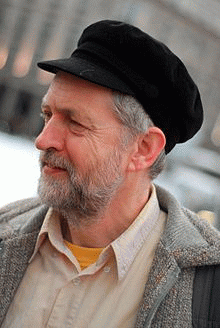British MP Jeremy Corbyn has proposed a "People's QE" that has critics crying hyperinflation and supporters saying it's about time.
Dark horse candidate Jeremy Corbyn, who is currently leading in the polls for UK Labour Party leadership, has included in his platform "quantitative easing for people." He said in a July 22nd presentation:
The 'rebalancing' I have talked about here today means rebalancing away from finance towards the high-growth, sustainable sectors of the future. How do we do this? One option would be for the Bank of England to be given a new mandate to upgrade our economy to invest in new large scale housing, energy, transport and digital projects: Quantitative easing for people instead of banks.
As his economic advisor Richard Murphy further explains it:
People's quantitative easing is . . . a highly directed process where the debt that is . . . repurchased has been deliberately created and issued either by a green investment bank or by local authorities, health trusts and other such agencies for the specific purpose of funding new investment in the economy at the time when big business and financial markets are completely failing to deliver the scale of investment that is needed to get the UK working again and to restore our financial prosperity.
According to the Positive Money group:
Ideas in a similar vein have been advocated or at least suggested by notable economists including J M Keynes (1), Milton Friedman (2), Ben Bernanke (3), William Buiter (4) and Martin Wolf (5). Most recently, Lord Adair Turner (6) has proposed similar ideas, highlighting that 'there are no technical reasons to reject this option'.
Perhaps, but critics have found plenty to criticize. Peter Spence writes in the UK Telegraph:
A victory for Jeremy Corbyn in the next general election would put Britain on a collision course with Brussels and condemn the UK to "Zimbabwe-style ruin", experts have warned.
. . . Tony Yates, a former Bank economist and now a professor at the University of Birmingham, said: "Down that road leads monetary policy ruin. . . . That's what Zimbabwe was doing, where they ended up paying all their bills by printing new money."
Spence also quoted Bank of England Governor Mark Carney, who said, "The reason why one doesn't even start on this conversation is the removal of any discipline on fiscal policy that comes from that."
The Bogus Hyperinflation Threat
Dire warnings of Zimbabwe-style hyperinflation have been leveled against quantitative easing (QE) ever since the Federal Reserve embarked on it in 2008. When the European Central Bank announced in January 2015 that it, too, would be engaging in QE -- along with the US, the UK and Japan -- alarmed commentators warned of currency wars, competitive beggar-thy-neighbor devaluations and hyperinflation. But QE has been going on since the late 1990s, and it hasn't happened yet. As Bernard Hickey observed in the New Zealand Herald on August 30th:
The US Federal Reserve cut its Official Cash Rate to almost 0 per cent in 2008 and has left it there. It launched three rounds of so-called quantitative easing and has only just stopped printing money to buy Government bonds.
(Note: You can view every article as one long page if you sign up as an Advocate Member, or higher).






